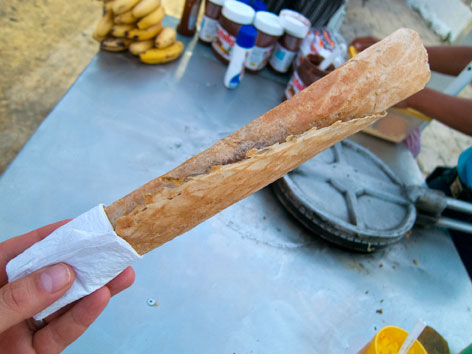
Edam cheese. Photo: Yvwv
Yucatecan food—even that found along the so-called Riviera Maya, the coastal corridor between Cancún and Tulum—is markedly different from “Mexican food” as most of us know it, as we learned while traveling the region last week. One reason is, of course, the pronounced Mayan influence, but many more groups have left their mark on the cuisine here as well, from the British and Spanish to the Lebanese and even the Dutch. The latter’s influence can be witnessed in one enduring main ingredient—Edam cheese, called queso de bola here—and is particularly unexpected for someone who’s traveled across much of Mexico before. No one knows for sure how the cheese got here: Some attribute it to Caribbean trade routes (or even a Dutch Antilles-bound boat blown off course); others claim wealthy Yucatecan hacienda owners who grew henequen, a fiber used to make rope, brought it back from their European travels. In any case, it’s there to stay. Two popular dishes, both delicious, demonstrate just how Yucatecans have adopted this foreign cheese as their own.

Queso relleno
Served in restaurants only, queso relleno is a monster of a dish, a filling, savory, meaty delight. It is, as the name translates, stuffed cheese: A round of Edam cheese is partially hollowed out—apparently, hacienda owners would eat the creamy innards and give the rinds to servants, one possible origin story of this dish—and filled with minced meat (pork or beef), raisins, nuts, various spices, sometimes olives and hard-boiled egg, and then it’s wrapped in muslin and steamed. Once nice and melty, it’s traditionally topped with two sauces: a red tomato sauce and a simple white, flour-based sauce called k’ool. It’s not the prettiest dish to look at, but it sure tastes good.

Marquesitas
A common street snack at busy corners and inside bustling zócalos, marquesitas are like crunchy crepes—a batter is poured into what looks like a waffle maker, sweet add-ins are thrown in, then the whole thing is wrapped up once crispy. The crepe itself tastes like a waffle cone—delicious—but it’s all about what you choose for inside, and through grueling research, we learned that the best combination is Nutella and queso de bola, which is shaved right into the crepe. It’s the perfect mix of sweet and salty inside a crunchy handheld shell. Good luck having just one!

Marquesita vendor










.jpg)

